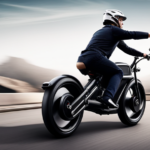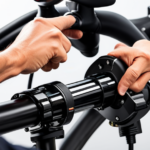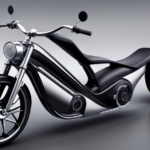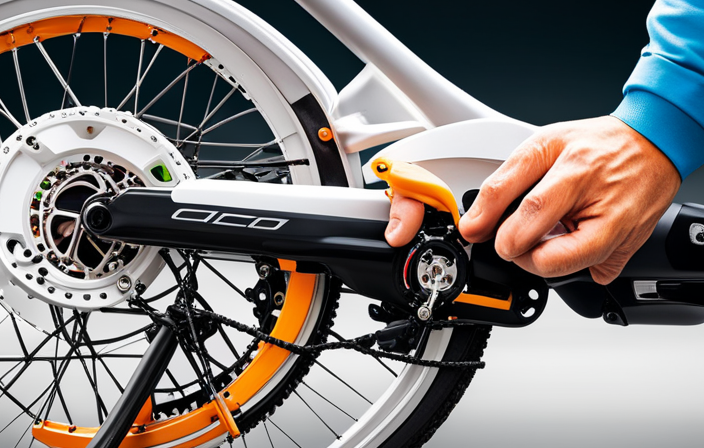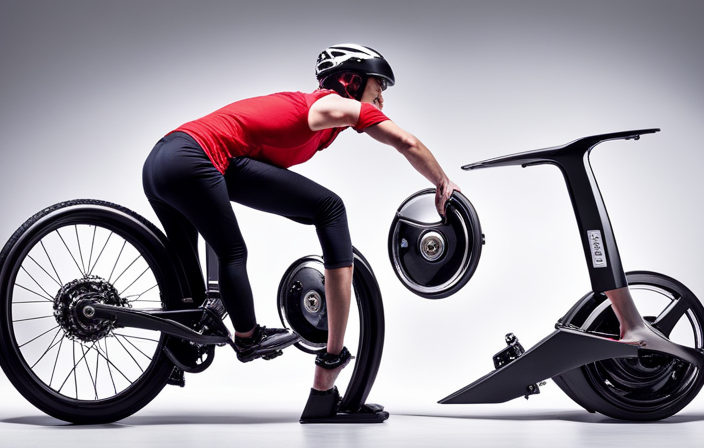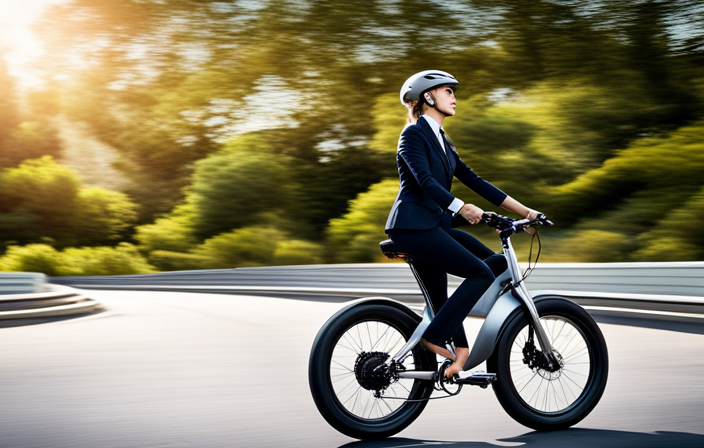Like the key to a locked door, the thumb throttle is the gateway to unlocking the full potential of your electric bike. This essential component allows you to effortlessly control your speed and power, providing a seamless riding experience.
However, there may come a time when you need to delve into the inner workings of your thumb throttle to make adjustments or repairs. In this article, I will guide you through the precise steps of opening a thumb throttle on an electric bike, ensuring a smooth and functioning ride every time.
Key Takeaways
- Gather the necessary tools such as small screwdrivers and needle-nose pliers before starting the process.
- Turn off the power of the electric bike for safety precautions.
- Identify visible screws or fasteners on the handlebar grip and throttle housing and look for hidden screws under protective covers or rubber seals.
- Carefully inspect the wiring connections, throttle mechanism, and internal components for any signs of damage, wear, or loose connections.
Gather the Necessary Tools
You’ll need to gather the necessary tools to open a thumb throttle on an electric bike. Choosing the right tools for opening a thumb throttle is crucial to ensure a successful process.
Start by acquiring a set of small screwdrivers with various sizes and heads, as they will be useful for removing screws and accessing the internal components of the throttle. Additionally, a pair of needle-nose pliers is essential for manipulating small parts and wires.
Common mistakes to avoid when opening a thumb throttle include using the wrong size screwdriver, which can strip the screws and make it difficult to open the throttle. It is also important to handle the components with care to avoid damaging any delicate wires or connections.
With the necessary tools at hand, you can now move on to the next step of turning off the power to the electric bike.
Turn off the Power
To deactivate the power, simply switch it off. Before opening the thumb throttle on an electric bike, it’s crucial to ensure that the power is completely turned off. This step is essential for your safety and to avoid any potential accidents.
Troubleshooting common issues with the thumb throttle often requires accessing the internal components, which can be dangerous if the power is still active. Once the power is off, you can proceed with opening the thumb throttle to troubleshoot any issues or perform regular maintenance.
In the next section, we will discuss how to locate the screws or fasteners that hold the thumb throttle in place, allowing us to gain access to the internal components.
Locate the Screws or Fasteners
First, find the screws or fasteners that secure the thumb throttle in place. To locate them, follow these steps:
-
Examine the handlebar grip: Look for any visible screws or fasteners near the thumb throttle. They are usually located on the inner side of the handlebar grip.
-
Check the throttle housing: Some electric bikes have a separate housing for the thumb throttle. Inspect the housing for any screws or fasteners that hold it in place.
-
Look for hidden screws: In some cases, the screws or fasteners might be concealed under a protective cover or rubber seal. Carefully remove these covers to access the hidden screws.
-
Find alternative methods: If you cannot locate any screws or fasteners, consult the manufacturer’s manual or contact customer support for alternative methods to open the thumb throttle.
By finding the screws or fasteners, you will be ready to move on to the next step of removing them to open the thumb throttle securely.
Remove the Screws or Fasteners
Once you have located the screws or fasteners, simply remove them to access the inner components of the thumb throttle. To replace the thumb throttle or troubleshoot any issues, it is essential to gain access to its internal parts.
Start by using a screwdriver or appropriate tool to unscrew the screws or remove the fasteners securing the thumb throttle in place. Carefully set aside the screws or fasteners in a safe place to avoid misplacement.
Once the screws or fasteners are removed, you will be able to separate the outer housing of the thumb throttle, revealing the internal wiring and components. This step is crucial for troubleshooting any issues or replacing the thumb throttle if necessary.
Transitioning into the subsequent section, carefully separate the thumb throttle to continue the process.
Carefully Separate the Thumb Throttle
Gently untwist or loosen the screws or fasteners to carefully separate the components of your thumb throttle. When performing thumb throttle maintenance or troubleshooting thumb throttle issues, it is essential to have a clear understanding of how the throttle is assembled.
By separating the thumb throttle, you gain access to the internal components, allowing you to inspect and address any potential problems. Pay close attention to the wiring connections, making sure they are secure and free from damage. Additionally, examine the throttle mechanism itself for any signs of wear or malfunction.
Inspecting the internal components will provide valuable insights into the overall condition of your thumb throttle and help you identify any necessary repairs or replacements.
Transitioning into the next section, let’s now move on to inspecting the internal components in more detail.
Inspect the Internal Components
When inspecting the internal components of the thumb throttle on an electric bike, it is important to check for any loose connections. This can be done by gently tugging on the wires and connectors to ensure they are securely attached.
Additionally, it is crucial to look for signs of damage or wear, such as frayed wires or cracked plastic casing. These can indicate potential issues that may affect the performance of the throttle.
Check for any Loose Connections
Make sure to check for any loose connections before opening the thumb throttle on an electric bike. This is an important step to ensure that the throttle functions properly and doesn’t cause any issues while riding.
To begin, inspect the wiring to see if there are any loose or disconnected wires. Carefully examine each connection point and gently tug on the wires to check for any movement. If you find any loose connections, tighten them securely using a screwdriver or appropriate tool.
Additionally, clean the throttle contacts using a soft cloth or a small brush to remove any dirt or debris that may be interfering with the connection.
Once you have checked for loose connections and cleaned the throttle contacts, you can proceed to the next step and look for signs of damage or wear.
Look for Signs of Damage or Wear
First, check for any signs of damage or wear on the connections and wiring of your e-bike. Inspecting for signs of damage or wear is an essential step in troubleshooting common thumb throttle issues. Look closely at the wires and connectors for any fraying, cuts, or exposed metal. Pay attention to any discoloration, indicating heat damage. Additionally, check for loose or broken parts, such as the handlebar grip or housing. These can affect the functionality of the thumb throttle. To help you identify potential issues, here is a table showcasing common signs of damage or wear and their possible causes:
| Sign of Damage or Wear | Possible Cause |
|---|---|
| Fraying or cuts in wires | Excessive tension or rubbing against sharp edges |
| Discoloration | Overheating or electrical short circuit |
| Loose or broken parts | Age, wear and tear, or impact damage |
By carefully inspecting these areas, you can determine if any adjustments or repairs are necessary to ensure the proper functioning of your thumb throttle.
Make any Necessary Adjustments or Repairs
After ensuring the bike is turned off, gently remove the screws holding the thumb throttle in place. Here are the necessary steps to make any adjustments or repairs to the thumb throttle:
-
Adjusting the sensitivity: Carefully examine the throttle mechanism to locate the sensitivity adjustment screw. Use a small screwdriver to turn the screw clockwise to increase sensitivity or counterclockwise to decrease it. Test the throttle response after each adjustment until the desired sensitivity is achieved.
-
Replacing worn-out parts: Inspect the throttle components for any signs of wear or damage. If you notice worn-out or broken parts, such as the throttle grip or the throttle cable, replace them with new ones. Ensure that the replacement parts are compatible with your specific bike model.
-
Reassemble the thumb throttle: Once the necessary adjustments or repairs are complete, securely fasten the thumb throttle back onto the handlebars. Make sure that all screws are tightened properly before turning the bike on.
Now, let’s move on to the next section about how to reassemble the thumb throttle.
Reassemble the Thumb Throttle
To put everything back together, you’ll need to securely attach the thumb throttle onto the handlebars and ensure that all screws are tightened properly.
First, position the thumb throttle onto the handlebars at your desired location. Take note of any alignment markers or indicators to ensure proper positioning.
Next, use a screwdriver to insert and tighten the screws provided with the thumb throttle. Make sure to apply firm pressure while tightening to ensure a secure fit.
Once all screws are tightened, give the thumb throttle a gentle tug to check for any looseness or wobbling. If everything feels secure, you can proceed to the next step. If not, double-check the screws and tighten as necessary.
Now, we can move on to testing the thumb throttle to ensure it functions properly.
Test the Thumb Throttle
Now you can check if the thumb throttle is functioning properly by giving it a gentle press and observing the response.
To ensure a successful test, follow these procedures:
- Pay attention to the throttle’s movement: Observe if it moves smoothly without any resistance or sticking points.
- Check for responsiveness: Press the throttle and verify if the motor engages promptly and consistently.
- Test the speed control: Gradually increase the throttle and confirm if the motor responds accordingly, accelerating smoothly.
- Evaluate the deceleration: Release the throttle and ensure that the motor slows down gradually instead of abruptly stopping.
These troubleshooting techniques will help identify any issues with the thumb throttle. If you encounter any problems during the test, refer to the previous subtopic on reassembling the thumb throttle for potential solutions.
With a properly functioning thumb throttle, you can now enjoy a smooth and responsive riding experience.
Enjoy a Smooth and Functioning Thumb Throttle
You can now fully appreciate the pleasure of riding with a smoothly functioning thumb throttle. Maintaining a thumb throttle on an electric bike is essential for a seamless riding experience.
Here are some tips for keeping your thumb throttle in top condition.
First, regularly inspect the throttle for any signs of wear or damage such as loose wires or broken components.
Clean the throttle with a soft cloth and mild detergent to remove any dirt or debris that may affect its performance.
Lubricate the moving parts with a silicone-based lubricant to ensure smooth operation.
If you encounter any issues with your thumb throttle, such as unresponsiveness or erratic behavior, try troubleshooting common problems like checking the battery connection, adjusting the throttle tension, or recalibrating the throttle sensor.
By following these maintenance tips and troubleshooting techniques, you can enjoy a consistently smooth and functioning thumb throttle on your electric bike.
Frequently Asked Questions
Can I open a thumb throttle on an electric bike without any tools?
I’m sorry, but it is not possible to open a thumb throttle on an electric bike without any tools. However, I can provide you with some thumb throttle maintenance tips to keep it in good condition.
How do I know if the power is completely turned off before opening the thumb throttle?
To safely open a thumb throttle on an electric bike, first ensure the power is completely turned off. If not, it could lead to unexpected movement. Check the power switch or disconnect the battery before proceeding.
Are there any specific types of screws or fasteners that I should be looking for when locating them on the thumb throttle?
When it comes to screw types and fastener compatibility on a thumb throttle, it’s important to be meticulous. Look for screws that fit snugly, like puzzle pieces, ensuring a secure and reliable connection.
What precautions should I take when separating the thumb throttle to avoid damaging any internal components?
To avoid damaging any internal components when separating the thumb throttle, I would recommend taking the following precautions: 1) Use a small screwdriver to carefully remove any visible screws. 2) Gently pry open the throttle casing using a plastic opening tool. 3) Take note of the position and orientation of the internal components before disassembling further.
Is it possible to make adjustments or repairs to the thumb throttle without any prior knowledge or experience?
Sure, it is possible to make adjustments or repairs to a thumb throttle without prior knowledge or experience. Common issues like sticky or unresponsive throttles can be fixed by cleaning or lubricating the mechanism. Regular maintenance and avoiding excessive force can prolong the throttle’s lifespan.
Conclusion
In conclusion, opening a thumb throttle on an electric bike is a straightforward process that can be done with the right tools and careful attention. By following the steps outlined in this article, you can ensure that your thumb throttle is in optimal condition and functioning smoothly.
Just like a well-oiled machine, a properly adjusted thumb throttle is like the key that unlocks the full potential of your electric bike, providing you with a seamless and enjoyable riding experience.


